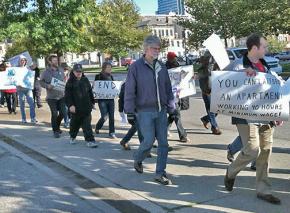Haves and have-nots in Over-the-Rhine
reports on the efforts of the Peoples' Coalition for Equality and Justice to fight gentrification in Cincinnati's historically Black Over-the-Rhine neighborhood.
A MEETING held in Cincinnati's Over-the-Rhine (OTR) neighborhood on January 24 to draw attention to the impact of gentrification.
The Peoples' Coalition for Equality and Justice (TPCEJ)--a group made up of neighborhood residents, members of the International Socialist Organization and activists in the Over-the-Rhine Peoples' Movement, which goes back four decades--met to discuss the changes occurring in the neighborhood, how they have affected residents and what could be done to keep people in their homes, as more and more pressure is put on low-income and minority residents to leave.
For many residents, the level of inequality is illustrated on a day-to-day basis. Kenya described the situation in frank detail, saying, "Poor people are getting kicked out, and the rich people are moving in."
Kenya stays in the Columbia building on Walnut Street, which stands on the corner of the current flagship redevelopment project in the neighborhood: Mercer Commons. Nearly an entire block was razed and $63 million was spent to build 28 condominiums, 124 apartments, a parking garage and retail space. Thirty apartments will be "affordable," however, their affordability will be based on market-rate prices.

While the senior management of the Cincinnati Center City Development Corporation (3CDC), the group responsible for the redevelopment, boasts that the affordable apartments will be available to those making around $28,000 a year, it is important to remember that OTR is in a neighborhood where the average household income barely exceeds $12,000. In the 2010 census, the location of the Mercer Commons development and the Columbia building was ranked as the most disparate income tract in the entire country.
The Columbia building was recently bought by 3CDC and the plan is to move current tenants out so that it too can be renovated for more affluent residents. Tenants like Kenya are unsure of where they will end up. Such is the general trend of the changes in OTR.
IN 2001, OTR was the site of a week of protests following the racist killing of Timothy Thomas, a 19-year-old Black man shot in the back by police officer Stephen Roach. The uprising brought gentrification, then occurring along Main Street, to an abrupt halt. But it has begun again, first slowly, but now with a renewed haste.
3CDC is a public-private partnership formed in 2003 to oversee redevelopment in the downtown area. It was created after the shuttering of Cincinnati's planning department, which was closed to fill a budget shortfall. The department's duties were outsourced to 3CDC almost wholesale.
In the past decade, 3CDC has been responsible for the renovation of Fountain Square (typically seen as the city's central gathering space), Washington Park in Over-the-Rhine, numerous retail and apartment buildings and is currently in the early stages of fixing up Music Hall, where the renowned Cincinnati Symphony Orchestra performs. These projects usually involve public spaces being partially privatized and put under control of 3CDC.
The Columbia renovation will not be the first time 3CDC has moved out low-income residents to remake a space. In 2009, 3CDC bought the Metropole Hotel and served eviction notices to its 200 low-income residents. When tenants resisted, 3CDC brought in the sheriff's department to force them to leave. After residents banded together and sued, 3CDC paid a $88,000 settlement, though, by the time the litigation was over, the damage had been done. Many former residents were living on the streets. Others could not be tracked down.
Today, the Metropole is the 21st Century Museum Hotel, where guests can stay for $250 a night--equivalent to several weeks rent prior to the renovation. The "Metropole" name is still used for the hotel's award winning restaurant, where a dinner will run you upwards of $30 an entree.
TPCEJ came out of a struggle around the Anna Louise Inn, an affordable housing complex for women located in Lytle Park, one of the most tranquil corners of Cincinnati's downtown and a minute's walk from the Ohio River.
The Inn has, for over 100 years, provided low-cost housing to working-class women. In the past several years, the Anna Louise Inn had a very successful program to help women with a history of drug use and prostitution get off the streets. Western & Southern (W&S), a financial giant and a member corporation of 3CDC, was the next-door neighbor of the Inn and was supportive of the programs it ran--until the Inn had plans to renovate the building.
W&S, led by CEO John Barrett, sued the Inn, claiming it violated code by serving as a "shelter." TPCEJ, then called the "Allies of the Anna Louise Inn," staged protests and meetings on an almost weekly basis to counter the actions of Barrett and W&S and to act as the unofficial street team while the litigation dragged on inside the courts.
After a few years and a series of legal victories for the Inn, followed by appeals from W&S, the Inn finally gave in, afraid they would be left with empty coffers and unable to deliver on their core mission if the case drug on for very much longer. They accepted a settlement of $4 million and agreed to move a few miles away to a less serene location on a busy street at the bottom of a hill.
The movement was devastated. What the Inn represented an antagonism that runs to the heart of capitalism: rich versus poor, propertied versus propertyless. TPCEJ emerged out of the reorganization that the defeat necessitated and set it sights on OTR specifically--and the problem of gentrification generally.
AT VARIOUS points during the January 24 meeting, the room erupted into shouting as attendees with interests in the redevelopment took up more than their fair share of time. A property owner cried crocodile tears and lamented that his buildings were being "attacked" by vandals and thieves.
The crowd confronted him in an appropriate manner, reminding him that for 40 years, lower-class Blacks and whites had been attacked by the system which first forced them to live in broken down neighborhoods like Over-the-Rhine, and is now showing them the door and kicking them out of they don't leave.
In an interview after the meeting, Jerry Davis, the civil rights coordinator for the Greater Cincinnati Coalition for the Homeless, admitted that the meeting "started out good in the beginning, but at some point [it] lost focus."
He continued, "I didn't like the way some people were howling at this guy because of the way he was making a living, but I resent the fact that he thought was being personally attacked." (As the property owner spoke of being attacked, he had held up a flier for the event, saying that the Coalition was the cause of his troubles.)
Others in attendance came to the man's defense, saying that we need to have more like him who were willing to invest to transform the neighborhood. A recent graduate of the University of Cincinnati's architectural program even boasted, non-ironically, that he hoped to be a "job creator" one day, happily playing the white savior by turning vacant storefronts into thriving businesses.
A member of TPCEJ who was directing the discussion at that point remarked that it was that kind of "solution" that was partly responsible for bringing the neighborhood to where it was at in the first place--for creating the kind of inequality and the accompanying conditions which force people out of the neighborhood.
The competing interests in the meeting were reminiscent of the broader antagonisms in the neighborhood which go back a long time. "It's wealthy versus poor," Kenya remarked afterward.
For now, it seems the wealthy are winning. In the 1990s the director of the OTR Chamber of Commerce once remarked that the neighborhood had become a "warehouse for the poor." In what is as much of a farce as it is a tragedy, the Drop Inn Center, a homeless shelter and one of OTR's oldest social service organizations, recently agreed to be moved to a warehouse in the downtown manufacturing district of Queensgate, over a mile from its current location.
The Peoples' Coalition will continue to organize in the neighborhood and hopes to build throughout the city. Other neighborhoods like Northside, Price Hill and Avondale are undergoing similar changes with very little resistance.
On a broader scale, Cincinnati, with a child poverty rate of over 50 percent and a segregated populace, must grapple with deeper questions and the need for a movement that poses long-term solutions.
In the end, Davis says, "It's all going to boil down to one thing: the haves and have-not."


